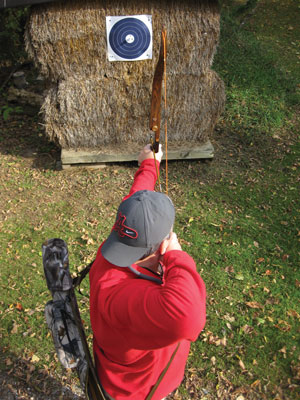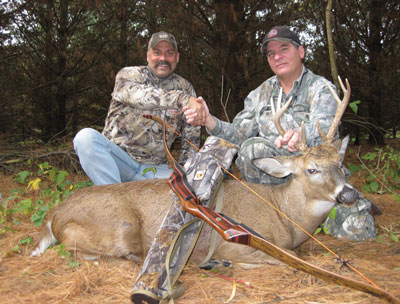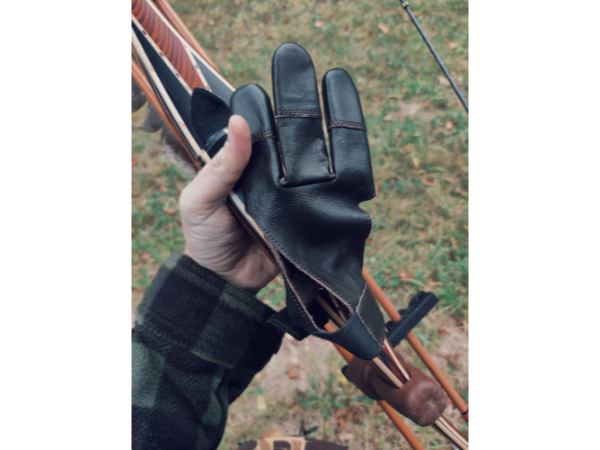You’ve done your shooting homework by establishing a repeatable, torque-free grip on the bow and locating an anchor point that places the nock under your dominant eye, aligning your draw arm elbow with the arrow. You’ve mastered the proper method of pulling with your back muscles and following through after the shot. The aiming system you decided to use is paying off and you know where to hold to hit the target. Things are going well—but then they aren’t. Mental issues can inhibit our ability and knowledge in this sport as well as others, as when a golfer develops the “yips.” It happens to newbies as well as old timers. The problems can be constant or only show up when you simply “have” to make the shot. It can be very frustrating to put in the time to learn, practice, and perfect your shot only to fail to perform to your potential.
The three most common mental errors I see are what I call short draw, drive-by shooting, and claw finger. Short draw occurs when the archer never quite gets to anchor, or does so in a jerky, uncontrolled movement. Drive-by shooting happens when the archer cannot hold on target. Some shooters can anchor and hold above, below, left, or right, but cannot relax at center and end up moving toward the target and releasing as they “drive by.” Claw finger means that the archer is anchored at full draw on target, but cannot conclude the shot smoothly without a nasty collapse or pluck.
I’ve had plenty of personal experience with short draw problems. Nothing has helped me deal with this issue more than the advice I received from my friend, Rod Jenkins. Rod is a long time bowhunter, two-time IBO world champion, and one of the top traditional archery coaches in the nation. Rod and I hunted whitetails together last fall, and I interviewed him for this column one evening.
Short Draw
We were standing in a long line to shoot the first target at the Great Lakes Longbow Invitational in the mid 1980s. The target was a 3-D deer shot across the water. The line of a hundred waiting shooters wrapped around the contour of a pond, allowing everyone to watch them and their results. I remember a big dude dressed like a mountain man stepping forward and touching a boot to the stake. He drew a shaft from a fur-covered back quiver and nocked it on the string of his longbow while he peered at the deer target, squatted down a little, and bent forward. Suddenly, he whipped the bow up, drew back maybe twelve inches past brace, and flung an arrow in the blink of an eye. His arrow lobbed out over the pond like a shot put and splashed in front of the target on the far bank. I can remember exchanging incredulous looks with my dad. To this day, that is the worst case of short draw I’ve ever witnessed.
Rod believes the root of the short draw problem comes from aiming too early in the shot sequence. It took me awhile to fully understand what he meant, but once it sunk in I had a plan to keep my anxiety controlled. “Stop trying to sneak up on it and just go to anchor. Once you start drawing, you have nothing else to do but go to anchor,” Rod told me more than once. I listened, but would still lock up short of anchor and try to pull while keeping the arrow aimed. I kept telling myself that I was just looking at the target and not aiming, but I was lining up the shot.
Rod finally got through when he asked me, “When do you start aiming a rifle?”
“After I have the butt in my shoulder and my cheek on the stock,” I answered.
“What do you do next?”
“I put my finger on the trigger.”
“Exactly! You follow the steps of a shot sequence in order. If you relate this to how you shoot your bow, you are aiming with your finger on the trigger before you have the stock to your shoulder,” Rod stated.
A little light came on inside my brain, and now my shooting is way more fun and accurate. I can look at the target, but don’t aim or focus until after I’m anchored. It didn’t slow down my shot, either. I wasn’t wasting time trying to “sneak up on it.” Aiming fast comes easily for most archers suffering from short draw syndrome; they can aim faster than they can draw to anchor.
Rod makes another great point about aiming too early. He says, “The human mind can only focus intently for a second or two. Why not be at top aiming focus when the shot breaks?”
So to overcome short draw all you have to do is keep the steps of the shot sequence in order. It sounds too good to be true—easy, even. For some like me though it takes a bit of work, because years of engraining aiming too early in the shot have to be overcome. Some of Rod’s students find it helpful to look at the face of the bow when drawing to stop the impulse to begin aiming too soon.

Practice no-fire drills to help prevent premature release of the arrow.
Drive-By Shooting
I was shooting at the IBO traditional world championships a few years ago with Rod Jenkins. On one round, we shot with a nice young man who would pull to anchor and freeze up to the right of the target. Swinging slowly to the left he would touch off the shot on the way through. I was amazed at how well he shot. I asked Rod about him later on.
“Yeah, that poor kid is a train wreck waiting to happen,” Rod replied. “You see a lot of shooters lock up above the target too. They try to time dumping the string with dropping the bow arm. It only works on days when all the planets and stars are aligned. The rest of the time, it’s not pretty.”
I saw the young shooter at a show after hunting season and asked him if he’d had any luck. He had three easy chip shots and missed all of them clean. He couldn’t believe it!
Rod believes drive-by shooting occurs when archers are not comfortable holding on target. He said, “The old advice to “burn a hole in the target” has their shooting step sequence screwed up. For most of these archers, attaining the target is triggering the release. Their subconscious is screaming at them to let go when the arrow tip gets anywhere near center. These archers need to take conscious control of their shot. Back to the firearms analogy, they have their safety off too soon.
“I realized many of my students were committed to the shot way too early in the shot sequence, sometimes when they put their fingers on the string. That is why I added the commitment step to the seven shooting steps I teach in my clinics. Not committing to the shot until the sight picture is right is the first step to recovery. It will take some work to engrain that new step into the shot routine. No-fire drills can also be helpful. These drills simply mean drawing to anchor, aiming several seconds, and then letting down. Once the archer stops triggering the shot by sight, they gain control of their shot and can be comfortable aiming on target.”
Claw Finger
I attended the Compton Rendezvous several years ago and shot one of the courses with a group of friends. One of the targets was an elevated mosquito hooked on a pivot arm. Directly behind the target was a large, pockmarked tree trunk on the edge of a huge, overgrown marsh. The group ahead of us was moving slowly and invited us to shoot through. One of the guys in our group stepped to the stake, bent at the waist, drew, anchored solidly, aimed, and held…and held. He started shaking like a rocket just before liftoff. The lady in the group ahead watched him with her mouth partially open in fascination. We all knew he should let down, but he let go instead. His string hand flew out like a rodeo bull rider. The arrow flew two feet right of the target, missed the tree, and arced out of sight.
Rod feels that claw finger is brought on by the shooter being afraid to pull or expand. They want to hold everything perfectly still so they don’t miss. They are more worried about results than shot sequence. “You often see the same thing with pro golfers missing a short putt or an NBA star missing an easy game winning shot,” he noted.
“These archers just need to aim and pull to conclusion with trust. They have ninety-five percent of the shot made. No one can hold perfectly still, but if you let the sight picture float and finish the shot strong, your subconscious will adjust and guide the arrow to the mark,” Rod said.

The author, left, with his friend Rod Jenkins.
“I believe these shooters should spend some time on a blank target bale, focus on the aiming and expansion step to the conclusion step, and buy into trusting what happens behind the bow. I also recommend that these archers spend some time at the firearms range. When you let the sights float, relax, and squeeze off the shots with trust and no anticipation accuracy soars. Doesn’t matter if it is a scoped rifle, handgun with open sights or a bow.”
Rod concluded, “Every great shot I’ve ever met has experienced mental problems at some point in their journey. The good news is that with some bale work, sticking with fundamentals, and trusting the shot sequence we can all overcome these mental issues and perform to our potential when we are in the field.”







Thanks to Denny for taking the time to investigate and write this article , and to Rod Jenkins for his input. I’ve been shooting this way for a couple or three years now ,ever since the written copy of TBM magazine put it out. Never looked back ! My shooting has me placing the arrow on point at all times , I’ve strayed a couple times but knowing what to do ha really helped . Thanks guys
Denny,
Thanks very much for this article, especially the short draw portion. I have been suffering from short draw/target panic and will incorporate “draw back and anchor” rather than “draw back and aim” into my shot sequence. Staring at the back of my hand or bow rather than fixating on the “target” might just help.
Mike from Colorado.
P.S. I’ve really enjoyed Ron Jenkins and your interviews on “The Push” podcasts. They brought me back to my days growing up in Wisconsin!
Excellent article Danny! Well done sir.
Amaizing article.
Please, can you explaing more regardin the seven steps of shot defiende.
Regars from Spain.
Good one, thanks for sharing!
Thanks for the article. I have definitely struggled with the “drive by” mental pattern for years. Hearing that others have faced this same challenge and worked through it gives me confidence to keep working at conquering it. Thanks
Twenty some years ago I went through severe target panic/short draw acquired after buying a video teaching the very thing Rod advises against–aiming before you draw the bow. I felt like a man cheating on his wife when I went to the dark side (compound). I still loved her but I had to get things done. It took years to overcome the panic and I shoot fair, sometimes great but not consistently great. This article caused me to reexamine my anchor and indeed it was not quite directly beneath the eye. I experimented and in a few minutes, lowering my anchor, the rifle (me) is now sighted in. I can\’t thank you enough. Sincerely, John Alden, Iowa
⭐️⭐️⭐️⭐️⭐️!
Great article, great illustrations, great analysis, well written great read.
Can we repost this article on our Facebook?
You are certainly welcome to post a link to this article on your Facebook page, or share it from our FB page. If that isn’t what you are asking, please email me at webmaster@tradbow.com
Hi Robin, this is Lester Dumm. Good article! More like it please. I have sent an email concerning a subscription. Thanks.
Good article it helped me with my shooting form. Best regards Peter